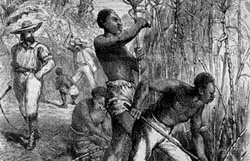Slavery and Abolitionism
During the original settlements in the ‘new world’, slavery of black people was common in a variety of countries including the African nations. Slaves were bought and sold as objects and slave owners in the growing new nation were both horrible and kind to their slaves. During the writing of the Constitution of the United States, many of the members that signed the document were slave owners; although many, such as John Adams, were against the idea of slavery.


Slavery had almost completely been removed from the northern states by the 1800’s, but the southern states still relied heavily on slaves to do all of the hard work in the fields. Many of the plantations had been built and succeeded only because of the slaves. Between the 1820’s and 1830’s there were a lot of people that began to raise objections to the slavery conditions of the south. The original ideas for those against slavery was to simply send them back to Africa. As they witnessed the horrors of slavery, they changed their minds to ‘emancipation’ (freedom).

The southern states were strongly against emancipation and this caused increased arguments between the northern and southern states. Southern states below what they called the ‘Mason-Dixon Line’ were pro-slavery and the states above this imaginary line were against slavery. People that wanted to end slavery were called ‘abolitionists’ and began calling others to their cause to be rid of this horrible type of free labor and the poor treatment of our fellow human beings. This movement was the beginning of some of the major causes for what would become the Civil War.


The abolitionist movement grew as white religious leaders spread the word across the country to free the slaves. Member’s efforts to help escaping slaves to freedom led to the publication of anti-slavery news by William Lloyd Garrison. The Government not only passed a law to capture escaping slaves, but put a bounty on Garrison’s head.
The development of a route for escaping slaves to take from the south to the north was called ‘The Underground Railroad’. People of all faiths went to extreme conditions to feed, clothe and allow slaves a place to rest, before they continued their journey north. In 1833, Garrison and a group of men met in Philadelphia, Pennsylvania to establish the American Anti-Slavery Society. The society grew in popularity among both white and black communities that it had hundreds of branches throughout the country, flooding information to the people.

The amount of literature that was being produced made many people that supported slavery angry enough to have mob attacks on the postal service, burning mailbags and the eventual passing of a ‘gag rule’ law that prevented people from sharing antislavery petitions. The 1837 murder of Elijah Lovejoy, an abolitionist editor, was the final reason that northerners voted in antislavery politicians.

Garrison’s group began to evaluate and add additional requirements so that women would be included in the freedom requests. The arguments within his group caused a number of splits, but it also added female abolitionists to their cause, many of whom would be later involved in the first independent feminist movement.

Speakers at that time brought the cause of freedom as part of the message of religion and the most well-known fugitive slaves such as Frederick Douglass, Wendell Phillips and Lucy Stone became the most famous and wrote popular autobiographies.

The Civil War was largely based on the disagreements between the north and south regarding slavery and when President Lincoln was elected to office and addressed the people regarding the end to slavery, the southern states, having lost the war knew that their time to have slaves had ended. The arguments continued until finally, the Fifteenth Amendment to the Constitution which declared the abolishment of slavery.




